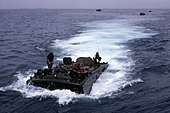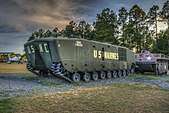LVTP-5
The LVTP-5 (Landing Vehicle, Tracked, Personnel) is a family of amphibious armored fighting vehicles used by the Philippine Marine Corps and formerly, the United States Marine Corps. It was designed by the BorgWarner company and built by FMC (Food Machinery Corporation) along with a few other companies. It was first accepted into service in 1956. Some 1,124 basic units were produced, plus the specialist variants, and many saw action in the Vietnam War.
| LVTP-5 | |
|---|---|
An LVTP-5 on display at the USS Alabama (BB-60) memorial in Mobile, Alabama. The front of the vehicle is facing right in this picture. | |
| Type | Armored personnel carrier |
| Place of origin | United States |
| Service history | |
| In service | 1956–present |
| Used by | See Operators |
| Specifications | |
| Mass | 37.4 t |
| Length | 9.04 m |
| Width | 3.57 m |
| Height | 2.92 m |
| Crew | 3+34 passengers |
Main armament | .30 caliber MG |
| Engine | Continental LV-1790-1 V-12 gasoline 704 hp |
| Power/weight | 19 hp/tonne |
| Suspension | Torsilastic |
Operational range | 306 km (road), 92 km (water) |
| Maximum speed | 48 km/h, in water 11 km/h |
History
It was an evolution of the LVT-1 to LVT-4 World War II era Landing Vehicle Tracked series, but was considerably larger and could carry 30-34 combat-armed troops. A smaller design based on the M59 APC was also produced as the LVT-6, but only a handful built.
The LVTP-5 was replaced in service by the LVT-7 family.
The most common type was the LVTP-5, an armored personnel carrier, with mine-sweeper, command, recovery and fire support variants, the latter mounting a 105 mm howitzer. An anti-aircraft version was prototyped, but never saw service.
As of the mid-2010s, the sole remaining state user of the LVTH-6 was the Philippines, who used 4 of them for their naval infantry force.[1][2] As of 2013, Philippine LVTH-6s came in a "digital"-style camouflage pattern.[1]
Variants
- LVTP-5 (Landing Vehicle Tracked, Personnel) - armored personnel carrier.
- LVTC-5 (Landing Vehicle, Tracked, Command) - command vehicle.
- LVTH-6 (Landing Vehicle, Tracked, Howitzer) - fire support variant armed with M49 105 mm howitzer. 210 units built.
- LVTR-1 (Landing Vehicle, Tracked, Recovery) - recovery vehicle. 65 units built.
- LVTE-1 (Landing Vehicle, Tracked, Engineer) - mine-sweeper. 41 units built.
- LVTAA-X1 (Landing Vehicle, Tracked, Anti Aircraft) - anti-aircraft variant, to be fitted with the turret of the M42 Duster. Only prototype built.
Operators


- Current



- Former
See also
References
- "LVTP-5 (1956)". Tanks Encyclopedia. 2016. Archived from the original on 2017-08-02.CS1 maint: BOT: original-url status unknown (link)
- "Philippine Marine Corps". www.globalsecurity.org.
- Dunham, George R (1990). U.S. Marines in Vietnam: The Bitter End, 1973–1975 (Marine Corps Vietnam Operational Historical Series). History and Museums Division Headquarters, U.S. Marine Corps. pp. 19–20. ISBN 9780160264559.
Further reading
- David Koller, LVTP5 Landing Vehicle Tracked Personnel 5, 2016, Highgloss Publishing, ISBN 9783033052598.
- SNL G277
- Steven Zaloga, Terry Hadler, Michael Badrocke - Amtracs: US Amphibious Assault Vehicles, 1999, Osprey Publishing (New Vanguard 30), ISBN 1-85532-850-X.